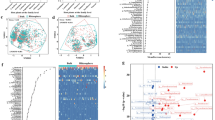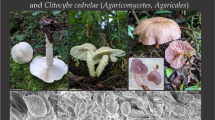Abstract
Sixteen Fusarium species were recovered from 52 asparagus commercial fields, representing all major ecological (edaphic and climatic) area of asparagus production in the province of Québec, eastern Canada. This study extends our understanding of the geographic range of these species. It also provides climatological and edaphic properties linked to community changes and adaptations. Fusarium oxysporum and F. proliferatum were omnipresent and abundant in all five ecological area under study, whereas F. redolens was less frequently found. Species of Fusarium that produce carmine red pigmentation on potato dextrose agar, i.e., F. acuminatum, F. avenaceum, etc., were common at the northern limit of asparagus production. Abundance of red Fusarium species corresponded with a low isolation frequency of F. proliferatum. Nevertheless, F. proliferatum had a high recovery rate throughout Québec asparagus growing areas, under climatic conditions as cold as those of northern Europe where this species is uncommon in asparagus fields. In the light of these results, redefinition of the geographical distribution of F. proliferatum in asparagus fields is proposed. Intraspecific molecular differences in F. proliferatum and F. oxysporum were detected in the EF-1 alpha sequences and compared with well-characterized strains of North America.








Similar content being viewed by others
References
GM Armstrong JK Armstrong (1966) ArticleTitleRelationships of Fusarium oxysporum formae speciales apii, aspargi, cassiae, melongenae and vasinectum race 3 as revealed by pathogenicity for common hosts Phytopathology 56 1256–1260
RP Baayen PHJF Boogert Particlevan den PJM Bonants JTK Poll WJ Blok C Waalwijk (2000) ArticleTitleFusarium redolens f. sp. asparagi, causal agent of asparagus root rot, crown rot and spear rot Eur J Plant Pathol 106 907–912 Occurrence Handle10.1023/A:1008766707266
D Backhouse LW Burgess (2002) ArticleTitleClimatic analysis of the distribution of Fusarium graminearum, F. pseudograminearum and F. culmorum on cereals in Australia Australas Plant Pathol 3 321–327
D Backhouse LW Burgess (1995) ArticleTitleMycogeography of Fusarium: climatic analysis of the distribution within Australia of Fusarium species in section Gibbosum Mycol Res 99 1218–1224
GL Bateman G Murray (2001) ArticleTitleSeasonal variations in populations of Fusarium species in wheat-field soil Appl Soil Ecol 18 117–128 Occurrence Handle10.1016/S0929-1393(01)00158-5
WJ Blok GJ Bollen (1997) ArticleTitleHost specificity and vegetative compatibility of Dutch isolates of Fusarium oxysporum f. sp. asparagi Can J Bot 75 383–393
WJ Blok GJ Bollen (1995) ArticleTitleFungi on the roots and stem bases of asparagus in the Netherlands: species and pathogenicity Eur J Plant Pathol 101 15–24 Occurrence Handle10.1007/BF01876090
NC Brady RR Weil (2001) The Nature and Properties of Soils Prentice-Hall Upper Saddle River, NJ, USA
LW Burgess (1981) General ecology of Fusaria PE Nelson TA Toussoun RJ Cook (Eds) Fusarium, Diseases, Biology, and Taxonomy Pennsylvania State University Press University Park, PA 225–235
LW Burgess CM Liddell BA Summerell (1988) Laboratory Manual for Fusarium Research EditionNumber2 University of Sydney Sydney
LW Burgess BA Summerell (1992) ArticleTitleMycogeography of Fusarium: survey of Fusarium species in subtropical and semi-arid grassland soils from Queensland, Australia Mycol Res 98 780–784
RM Clear SK Patrick (1999) ArticleTitleFusarium head blight pathogens isolated from fusarium-damaged kernels of wheat in western Canada, 1993 to 1998 Can J Plant Pathol 22 51–60
SI Cohen FD Heald (1941) ArticleTitleA wilt and root rot of asparagus caused by Fusarium oxysporum (Schlecht) Plant Dis Rep 25 503–509 Occurrence Handle1:CAS:528:DyaH38XhvFeksw%3D%3D
KS Elias RW Schneider MM Lear (1991) ArticleTitleAnalysis of vegetative compatibility groups in nonpathogenic population of Fusarium oxysporum isolated from symptomless tomato roots Can J Bot 69 2089–2094
WH Elmer (2003) ArticleTitleLocal and systemic effects of NaCl on root composition, rhizobacteria, and Fusarium crown and root rot of asparagus Phytopathology 93 186–192
WH Elmer (2001) Fusarium diseases of asparagus BA Summerell JF Leslie D Backhouse WL Bryden LW Burgess (Eds) Fusarium: Paul E. Nelson Memorial Symposium APS Press St. Paul, MN 248–262
WH Elmer (2001) ArticleTitleSeeds as vehicles for pathogen importation Biol Invasions 3 263–271 Occurrence Handle10.1023/A:1015217308477
WH Elmer (1995a) ArticleTitleA single mating population of Gibberella fujikuroi (Fusarium proliferatum) predominates in asparagus fields in Connecticut, Massachusetts, and Michigan Mycologia 87 68–71
WH Elmer (1995) ArticleTitleAssociation between Mn-reducing root bacteria and NaCl applications in suppression of Fusarium crown and root rot of asparagus Phytopathology 85 1461–1467
WH Elmer (1991) ArticleTitleVegetative compatibility groups of Fusarium proliferatum from asparagus and comparisons of virulence, growth rates, and asparagus residue colonization among groups Phytopathology 81 852–857
WH Elmer DA Johnson GI Mink (1996) ArticleTitleEpidemiology and management of diseases causal to asparagus decline Plant Dis 80 117–125
WH Elmer BA Summerell LW Burgess D Backhouse AA Abubacker (1997) ArticleTitleFusarium species associated with asparagus crowns and soil in Australia and New Zealand Australas Plant Pathol 26 255–261
WH Elmer CT Stephens (1989) ArticleTitleClassification of Fusarium oxysporum f. sp. asparagi into vegetatively compatible groups Phytopathology 79 88–93
WH Elmer CT Stephens (1989) ArticleTitleClassification of Fusarium oxysporum f. sp. asparagi into vegetatively compatible groups Phytopathology 79 88–93
D Fravel C Olivain C Alabouvette (2003) ArticleTitleFusarium oxysporum and its biocontrol New Phytol 157 493–502 Occurrence Handle10.1046/j.1469-8137.2003.00700.x
W Gerlach H Nirenberg (1982) The Genus Fusarium—a Pictorial Atlas. Mittelungen aus der Biologishen Bundesansalt für Land-und Forstwirtschaft, Heft 209 Verlag Paul Parey Berlin
H Germain G Laflamme L Bernier B Boulet RC Hamelin (2002) ArticleTitleDNA polymorphism and molecular diagnosis in Inonotus spp Can J Plant Pathol 24 194–199 Occurrence Handle1:CAS:528:DC%2BD38Xlt1OktLs%3D
WL Gordon (1952) ArticleTitleThe occurrence of Fusarium species in Canada. II. Prevalence and taxonomy of Fusarium species in cereal seed Can J Bot 30 209–251
KM Graham (1955) ArticleTitleSeedling blight, a fusarial disease of asparagus Can J Bot 33 374–400
RG Grogan KA Kimble (1959) ArticleTitleThe association of Fusarium wilt and root rot with the asparagus decline and replant problem in California Phytopathology 49 122–125
AD Kent EW Triplett (2002) ArticleTitleMicrobial communities and their interactions in soil and rhizosphere ecosystems Annu Rev Microbiol 56 211–236 Occurrence Handle10.1146/annurev.micro.56.012302.161120 Occurrence Handle1:CAS:528:DC%2BD38Xos1Gis7s%3D Occurrence Handle12142496
JF Leslie CAS Pearson PE Nelson TA Tousson (1990) ArticleTitleFusarium spp. from corn, sorghum, and soybean fields in the central and eastern United States Phytopathology 80 343–350
J Louvet C Alabouvette F Rouxel (1981) Microbiological suppressiveness of some soils to Fusarium wilts PE Nelson TA Toussoun RJ Cook (Eds) Fusarium—Diseases, Biology and Taxonomy Pennsylvania State University Press University Park, PA 261–275
WFO Marasas LW Burgess RY Anelich SC Lamprecht DJ Schalkwyk Particlevan (1988) ArticleTitleSurvey of Fusarium species associated with plant debris in South African soils S Afr J Bot 54 63–71
DG Maynard YP Kalra (1993) Nitrate and exchangeable ammonium nitrogen MR Carter (Eds) Soil Sampling and Methods of Analysis Canadian Society of Soil Science, Lewis Publishers Boca Raton, FL 25–38
PE Nelson TA Toussoun WFO Marasas (1983) Fusarium Species: An Illustrated Manual for Identification Pennsylvania State University Press University Park, PA
K O'Donnell (2000) ArticleTitleMolecular phylogeny of the Nectria haematococca–Fusarium solani species complex Mycologia 92 919–938
K O'Donnell HC Kistler E Cigelnik R Ploetz (1998) ArticleTitleMultiple evolutionary origins of the fungus causing Panama disease of banana: concordant evidence from nuclear and mitochondrial gene geanologies Proc Natl Acad Sci 95 2044–2049 Occurrence Handle10.1073/pnas.95.5.2044 Occurrence Handle9482835
C Sadowski M Knaflewski (1990) ArticleTitleSusceptibility of selected asparagus cultivars to Fusarium spp. under field conditions Acta Hortic 27 343–352
AE Sangalang LW Burgess D Backhouse J Duff M Wurst (1995) ArticleTitleMycogeography of Fusarium species in soils from tropical, arid and mediterranean regions of Australia Mycol Res 99 523–528
S Sanogo XB Yang (2000) ArticleTitleRelation of sand content, pH, potassium and phosphorus nutrition to the development of sudden death syndrome in soybean Can J Plant Pathol 23 174–180
Saremi, H, Backhouse, D, Burgess, LW (1997) Mycogeographic survey of Fusarium species in southeastern New South Wales. Fifth European Fusarium Seminar. Szeged, Hungary, pp 611–612
Saremi, H, Backhouse, D, Burgess, LW (1997) Soil environment effects on competition between Fusarium species. Fifth European Fusarium Seminar. Szeged, Hungary, pp 613–614
W Schreuder SC Lamprecht WFO Marasas FJ Calitz (1995) ArticleTitlePathogenicity of three Fusarium species associated with asparagus decline in South Africa Plant Dis 79 177–181
T Sen Tran RR Simard (1993) Mehlich III-extractable elements MR Carter (Eds) Soil Sampling and Methods of Analysis Canadian Society of Soil Science, Lewis Publishers Boca Raton, FL 39–42
BH Sheldrick C Wang (1993) Particle size distribution MR Carter (Eds) Soil Sampling and Methods of Analysis Canadian Society of Soil Science, Lewis Publishers Boca Raton, USA 499–512
BA Summerell B Salleh JF Leslie (2003) ArticleTitleA utilitarian approach to Fusarium identification Plant Dis 87 117–128
DL Swofford (2000) PAUP (and Other Methods). Phylogenetic Analysis Using Parsimony Sinauer Associates Sunderland, MA
MA Tabatabai (1982) Soil enzymes AL Page (Eds) Methods of Soil Analysis American Society of Agronomy Madison, WI 903–947
JD Thompson TJ Gibson F Plewniak F Jeanmougin DG Higgins (1997) ArticleTitleThe ClustalX windows interface: flexible strategies for multiple sequence alignment aided by quality analysis tools Nucleic Acids Res 24 4876–4882
U Thrane (1989) Fusarium species and their specific profiles of secondary metabolites J Chelkowski (Eds) Fusarium: Mycotoxins, Taxonomy and Pathogenicity Elsevier Amsterdam 199–225
H Tissen JO Moir (1993) Total and organic carbon MR Carter (Eds) Soil Sampling and Methods of Analysis Canadian Society of Soil Science, Lewis Publishers Boca Raton, FL 187–200
JMM Bakel ParticleVan JJK Kertsen (1970) ArticleTitleFoot rot in asparagus caused by Fusarium oxysporum f. sp. asparagi Neth J Phytopathol 76 320–325
RP Voroney JP Winter RP Beyaert (1993) Soil microbial biomass C and N MR Carter (Eds) Soil Sampling and Methods of Analysis Canadian Society of Soil Science, Lewis Publishers Boca Raton, FL 277–287
V Vujanovic C Hamel S Jabaji-Hare M St-Arnaud (2002) ArticleTitleDevelopment of a selective myclobutanil agar (MBA) medium for the isolation of Fusarium species from asparagus fields Can J Microbiol 48 841–847 Occurrence Handle10.1139/w02-082 Occurrence Handle1:CAS:528:DC%2BD38XovVaqtrs%3D Occurrence Handle12455616
Acknowledgments
This research was financially supported by a CORPAQ grant. The authors are thankful to Dr Wade Elmer, phytopathologist from the Connecticut Agricultural Experiment Station, New Haven, CT, USA, for the loan of US Fusarium specimens as well as for manuscript review and useful comments. We thank Dr. Robert Baayen, from the Plant Protection Service, Mycology Section, Wageningen, The Netherlands, and Dr Lily Tamburic-Ilincic, from the University of Guelph, Guelph, Ontario, Canada, for providing fungal strains. We also thank Jean-Guy Tessier, agronomist from the MAPAQ, for useful professional advice, and Houda Jallal, Université de Montréal, for technical assistance.
Author information
Authors and Affiliations
Corresponding authors
Rights and permissions
About this article
Cite this article
Vujanovic, V., Hamel, C., Yergeau, E. et al. Biodiversity and Biogeography of Fusarium Species from Northeastern North American Asparagus Fields Based on Microbiological and Molecular Approaches. Microb Ecol 51, 242–255 (2006). https://doi.org/10.1007/s00248-005-0046-x
Received:
Accepted:
Published:
Issue Date:
DOI: https://doi.org/10.1007/s00248-005-0046-x




